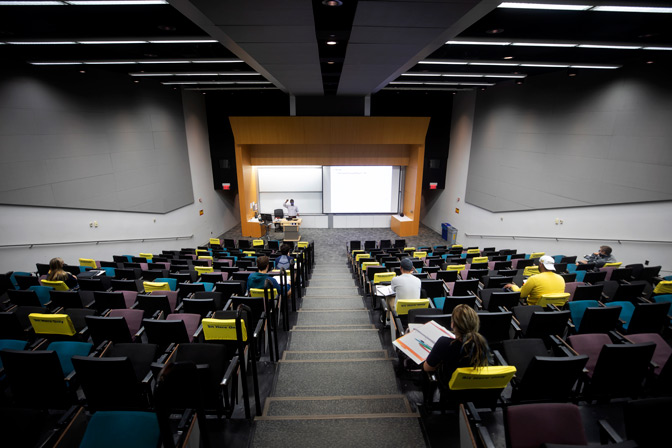
Michigan Engineering group creates model for layering COVID-19 defenses
The model can be used as a tool to inform decision-makers and individuals on relative risks and advantages associated with a layered defense.

The model can be used as a tool to inform decision-makers and individuals on relative risks and advantages associated with a layered defense.
University of Michigan researchers have created a simulation model to allow individuals and decision-makers to analyze how various risk reduction actions can create layers of defense against COVID-19—and how effective those defenses are likely to be.
The modeling of relative risks, conducted by the Center for Risk Analysis Informed Decision Engineering, analyzes vaccination rates, masks, and inactivating the virus with ultraviolet light. Applied to a specific set of classrooms and courses, the model provides relative risks against COVID-19 based on utilizing different combinations of the defensive actions.
“This model does not provide a prediction of the future,” said Seth Guikema, co-lead of the project and a professor of industrial and operations engineering. “It provides a tool to inform both individuals and decision-makers about relative risks and advantages associated with various interventions to reduce risk. If, for example, you have vaccination and masking in place, how much additional risk reduction do you get from adding in-room countermeasures such as HEPA filters or UVC virus deactivation?”

The actions are dependent on the environment, and no one action offers sufficient risk management on its own. A layered approach is critical says Guikema. “In a situation like an elementary school where we cannot reach immunity because we cannot currently vaccinate students, many other layers of defense must be considered, such as masking, moving lunch periods outside, and adding HEPA or UV fans to manage risk,” said Guikema. “Even in an environment where vaccinations have been mandated, such as what we have at the University of Michigan, additional layers of defense remain critical because vaccination is a brittle defense. Without additional layers of defense our risk mitigation plans are susceptible to failure if a new variant better evades the current vaccines.”
“The most important goal is not to achieve zero infections but rather to minimize harm to the individual student, staff, faculty, or those in the community. To achieve this we have to look beyond infections and to outcomes such as the probability of hospitalizations and deaths,” said Jim Bagian, co-lead of the project and a clinical professor of industrial operations and engineering. “And the Delta variant shows that there is no one silver bullet, such as vaccine, that will reduce the risks from COVID-19 to zero. You must pursue a more comprehensive approach that is based on a collection of mitigation activities, creating what we call ‘defense in depth’ to offer a more robust and resilient reduction in risk of infection or harm from COVID-19 using a multi-layered approach to provide robustness such as in the case of variants of COVID-19 against which the vaccine may have less effectiveness.”
Spooled up as part of five “Skunkworks” groups activated during Michigan Engineering’s preparations for returning to in-person classes in Fall 2021, the modeling is different than others released in that previous models have made large simplifying assumptions at institutional or regional levels. This model takes an individual level approach and can be applied to any aerosol-transmitted virus, allowing it to be useful for both decision-makers on behalf of organizations and individuals who are assessing their own personal risk.
“Institutions are not simply brick and mortar – they are composed of people. And everyone is different, with a need to assess individual risk for themselves,” said Bagian. “People don’t live in a bubble. They go out into their communities and home to their families. So, if they know that coming into a classroom or place of work provides a specific level of risk of contracting the virus, they can then decide how to layer their own defenses as they engage in their homes and communities to arrive at a level of risk that is acceptable to them.”
The paper, titled “COVID-19 simulation-based risk analysis for in-person learning,” has been published on the preprint server medRxiv.
Guikema is also a professor of civil and environmental engineering. Bagian is also clinical professor of aerospace engineering and research professor of anesthesiology.
Jennifer Judge Hensel
Executive Director, Communications & Marketing